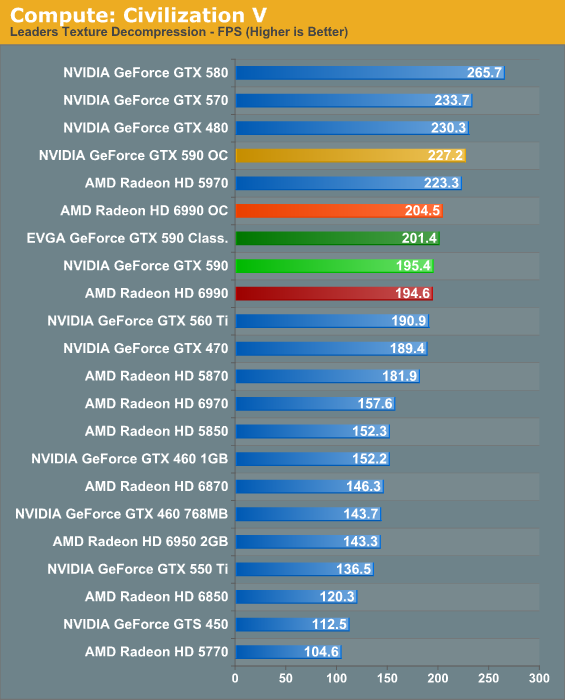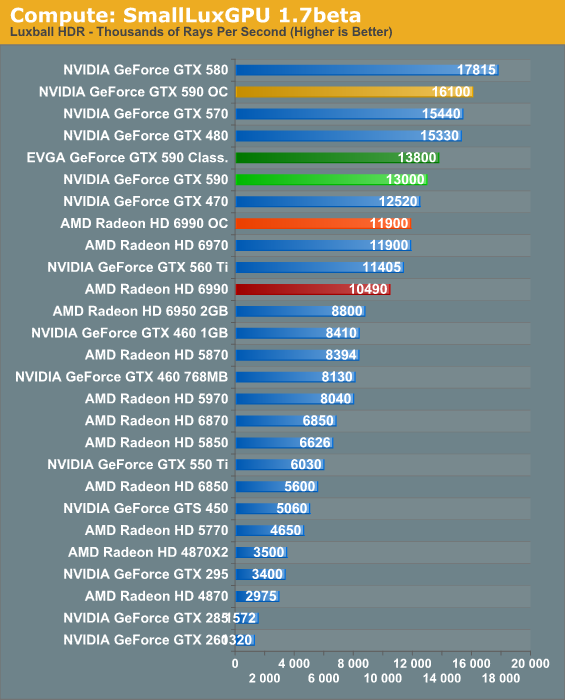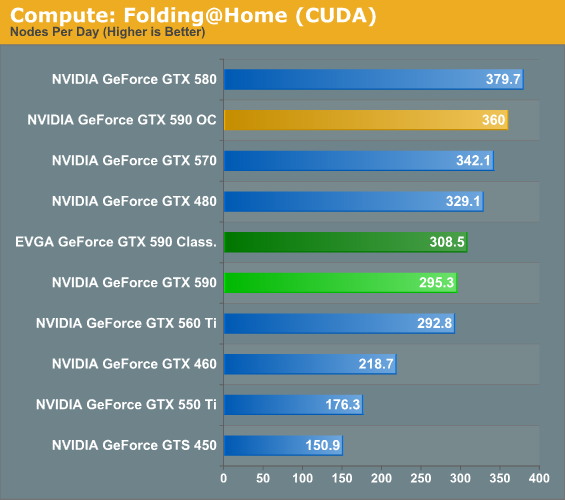NVIDIA’s GeForce GTX 590: Duking It Out For The Single Card King
by Ryan Smith on March 24, 2011 9:00 AM ESTCompute
Moving on from our look at gaming performance, we have our customary look at compute performance.
Our first compute benchmark comes from Civilization V, which uses DirectCompute to decompress textures on the fly. Civ5 includes a sub-benchmark that exclusively tests the speed of their texture decompression algorithm by repeatedly decompressing the textures required for one of the game’s leader scenes.

In the game world Civ5 benefits significantly from SLI and CrossFire. For our texture compression test however AFR is more a liability than a benefit. This doesn’t impact the game in any meaningful manner, but it’s an example of how SLI/CF aren’t always the right tool for the job. Unfortunately for both parties, with as few compute applications as there are today, almost none of them benefit from SLI/CF.
Our second GPU compute benchmark is SmallLuxGPU, the GPU ray tracing branch of the open source LuxRender renderer. While it’s still in beta, SmallLuxGPU recently hit a milestone by implementing a complete ray tracing engine in OpenCL, allowing them to fully offload the process to the GPU. It’s this ray tracing engine we’re testing.

SmallLuxGPU only currently supports ray tracing with one GPU, so all of our results are effectively proxies for what would be if the GTX 590 only had one GPU. Not surprisingly overclocks do wonders here, and NVIDIA’s strong compute architecture gives them an easy win. SLI/CF performance will become more important here when we upgrade to LuxMark for our next iteration of our benchmark suite, as LuxMark can handle multiple OpenCL drivers.
Our final compute benchmark is a Folding @ Home benchmark. Given NVIDIA’s focus on compute for Fermi, cards such as the GTX 590 can be particularly interesting for distributed computing enthusiasts, as two GPUs should be able to quickly retire work units.

Folding@Home doesn’t directly benefit from CF/SLI at all. However by dispatching one WU to each GPU it’s possible to double effective performance. With that taken into account the GTX 590 is quite an effective cruncher, particularly when we start looking at overclocking.










123 Comments
View All Comments
buhusky - Friday, March 25, 2011 - link
anybody else remember back in the era when pentiums just kept getting bigger & hotter every year? i wonder when they'll start making gpus smaller, cooler, quieter like they finally ended up doing with CPUskrumme - Saturday, March 26, 2011 - link
Yeaa, then this card is on of the first Pentium3 1Ghzryan1e - Saturday, March 26, 2011 - link
no offense anandtech, but this card is aimed squarely at the bleeding edge consumers much like the amd 6990 is. to that extent, any video card can only add performance to a system with respect to how much the system can deliver on the cpu side. as for the base system itself, it's a basic rig, nothing spectacular now. the gtx 590 and the amd 6990 restively would both perform better, and your results would prove more the limitations and capabilities of those cards if they were being run on the platforms they were targeted for. an example of what i mean: tom's hardware used a test platform based on an intel i7-990x OC to 4ghz paired to an asus rampage III formula mb vs. anandtech's older i7-920 clocked at 3.33 ghz paired to an asus rampage II extreme mb. the review from toms hardware nvidia's gtx 590 and amd's 6990 both performed far better than on anand's rig, but still similar overall. personally, i think i'll stick with my sli gtx 580 oc water cooled setup for performanceand get an upgrade for my cpu, neither the 6990 or 590 in any configuration is worth the expense for the miniscule gain in performance on the graphics side.mino - Saturday, March 26, 2011 - link
One word: comparability.mino - Saturday, March 26, 2011 - link
Another important review from AT, another biased review from AT. GRRR.- AT chooses NOT TO overclock HD6990 BUT presents un-overclocked results as HD6990 OC
Yeah, it could embarrass our masters if AMD's built-to-overclock card was presented deemed overclockable
- "The GTX 590 simply embarrasses the 6990 here; it’s not even a contest."
Yeah, 4dB is no contest, embarrassment, of course. It is AMD's card after all. (it is louder, no question there)
PR mercenaries at their best. Lets brace ourselves for another round of PR warfare when BD and Llano launch ...
nitrousoxide - Wednesday, March 30, 2011 - link
Don't you know that noise level goes by factor of 10 with 10dB increase? Do the math, and you will find 6990 2 times louder than 590. Indeed it's no contest. You can check out Linus Tech Tips' video review you Youtube. 6990 is definitely much, much louder than 590.The article itself isn't biased. 6990 and 590 have similar win-some-lose-some situation just like most cards at similar price range (570 vs. 6970, 560 vs. 6950, 460 vs. 6850 etc.) Darn it's impossible to have a real card king these days when both NV and AMD are paying developers for optimization.
OblivionLord - Sunday, March 27, 2011 - link
Anyone know what case was used in this test because if different cases were used then that could affect the temp chart.ryedizzel - Wednesday, March 30, 2011 - link
another excellent and incredibly thorough article. this is why i come back to Anandtech time and time again for the "real" story. thank you and please keep up the good work! :)trogthefirst - Thursday, March 31, 2011 - link
Actually if i wanted near the top gaming performance i would just fork out for 2 x HD 6950s, crossfire and possibly unlock them as a bonus :P Tadaa!rav55 - Thursday, March 31, 2011 - link
What good is it if you can't buy it? Nvidia cherry picked the gpu's to work on this card and they could only release a little over 1000 units. It is now sold out in the US and available in limited amounts in Europe.Basically the GTX 590 is vapourware!!! What a joke!